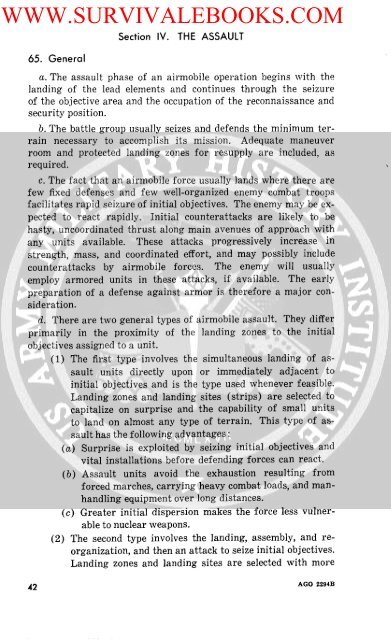FM 57-35 Airmobile Operations - Survival Books
FM 57-35 Airmobile Operations - Survival Books
FM 57-35 Airmobile Operations - Survival Books
- No tags were found...
You also want an ePaper? Increase the reach of your titles
YUMPU automatically turns print PDFs into web optimized ePapers that Google loves.
WWW.SURVIVALEBOOKS.COM65. GeneralSection IV. THE ASSAULTa. The assault phase of an airmobile operation begins with thelanding of the lead elements and continues through the seizureof the objective area and the occupation of the reconnaissance andsecurity position.b. The battle group usually seizes and defends the minimum terrain necessary to accomplish its mission. Adequate maneuverroom and protected landing zones for resupply are included, asrequired.c. The fact that an airmobile force usually lands where there arefew fixed defenses and few well-organized enemy combat troopsfacilitates rapid seizure of initial objectives. The enemy may be expected to react rapidly. Initial counterattacks are likely to behasty, uncoordinated thrust along main avenues of approach withany units available. These attacks progressively increase instrength, mass, and coordinated effort, and may possibly includecounterattacks by airmobile forces. The enemy will usuallyemploy armored units in these attacks, if available. The earlypreparation of a defense against armor is therefore a major consideration.d. There are two general types of airmobile assault. They differprimarily in the proximity of the landing zones to the initialobjectives assigned to a unit.(1) The first type involves the simultaneous landing of assault units directly upon or immediately adjacent toinitial objectives and is the type used whenever feasible.Landing zones and landing sites (strips) are selected tocapitalize on surprise and the capability of small unitsto land on almost any type of terrain. This type of assault has the following advantages:(a) Surprise is exploited by seizing initial objectives andvital installations before defending forces can react.(b) Assault units avoid the exhaustion resulting fromforced marches, carrying heavy combat loads, and manhandling equipment over long distances.(c) Greater initial dispersion makes the force less vulnerable to nuclear weapons.(2) The second type involves the landing, assembly, and reorganization, and then an attack to seize initial objectives.Landing zones and landing sites are selected with more42 AGO 2294B
















